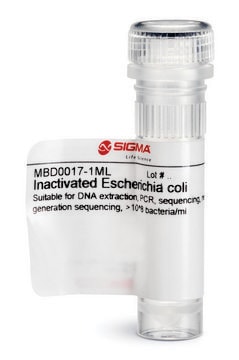The cells in this product are expected to be viable and may grow in culture, but it's important to note that the product is not intended for culture use. The material is not handled aseptically during manufacturing, so it is likely that other organisms would be present. The main purpose of this product is to serve as a biomass, specifically for the extraction of biomolecules such as DNA and lipids. It's important to understand that there is no guarantee of viability or purity. If the end user wishes to reconstitute the product for culture, they should add 0.3 to 0.4 ml of suitable liquid medium/broth to the freeze-dried material and mix it well. Then, they should transfer the total mixture to a culture tube or plate containing 5 - 6 mL medium/broth. It's worth noting that there is no cell count estimate available for this product.
EC11303
Escherichia coli
Strain B, lyophilized cells
Synonyme(s) :
E. coli
Sélectionner une taille de conditionnement
268,00 €
Sélectionner une taille de conditionnement
About This Item
268,00 €
Produits recommandés
Niveau de qualité
Stérilité
non-sterile (not processed or packaged aseptically)
Forme
lyophilized cells
Adéquation
not intended for starter culture
Température de stockage
−20°C
Vous recherchez des produits similaires ? Visite Guide de comparaison des produits
Catégories apparentées
Description générale
Code de la classe de stockage
11 - Combustible Solids
Classe de danger pour l'eau (WGK)
WGK 3
Point d'éclair (°F)
Not applicable
Point d'éclair (°C)
Not applicable
Équipement de protection individuelle
Eyeshields, Gloves, type N95 (US)
Faites votre choix parmi les versions les plus récentes :
Certificats d'analyse (COA)
Vous ne trouvez pas la bonne version ?
Si vous avez besoin d'une version particulière, vous pouvez rechercher un certificat spécifique par le numéro de lot.
Déjà en possession de ce produit ?
Retrouvez la documentation relative aux produits que vous avez récemment achetés dans la Bibliothèque de documents.
-
Could you provide the reconstitution method and concentration for product EC11303 under the brand SIGMA?
1 réponse-
Utile ?
-
-
What is the method of reconstitution for this product and what is the concentration?
1 réponse-
These cells are expected to be viable and may grow in culture. However, the product is not intended for culture use. The material is not handled aseptically during manufacturing, therefore other organisms would likely be present. The product is intended to serve as a biomass, i.e., for the extraction of biomolecules such as DNA and lipids. There is no guarantee of viability or purity. Should the end user wish to reconstitute the product for culture, add to the freeze-dried material 0.3 to 0.4 ml of suitable liquid medium/broth and mix well. Transfer the total mixture to a culture tube or plate containing 5 - 6 mL medium/broth. There is no cell count estimate available.
Utile ?
-
Filtres actifs
Notre équipe de scientifiques dispose d'une expérience dans tous les secteurs de la recherche, notamment en sciences de la vie, science des matériaux, synthèse chimique, chromatographie, analyse et dans de nombreux autres domaines..
Contacter notre Service technique







